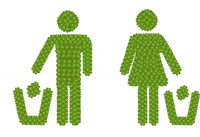•Adult diapers and briefs currently make up 7% of our nation’s landfill?
•Baby diapers currently contribute just 2-3% of landfill waste?
•Diapers are the third largest type of landfill waste?
•The average adult diaper or brief will take up to 200 years to decompose (the same amount of time as an aluminum can)?
In the coming years, adult diapers will contribute an increasing percentage to our landfills. Not only are adult diapers and briefs larger than baby diapers, but the number of adults using diapers is on the rise.
Most diapers go into landfills, which exist on the edge of cities and towns and are eventually covered by dirt. As towns and cities expand over time, they appropriate and build on top of these landfills. Housing developments spread across these previous trash dumps, leading some to wonder what future archaeologists will think when excavating these sites. Will they wonder about the anthropological meaning of so much plastic-backed paper products?
Reducing Your Carbon Footprint
If you or someone you know uses adult diaper products, there are two major ways to reduce your carbon footprint, or as some call it, your carbon “buttprint”:
- Use diaper boosters or diaper doublers. These are pads that go inside adult diapers, providing extra absorption and making each diaper last longer.
- Use long-lasting adult diapers. These diapers have been very popular in Europe and are available mostly online. While the average store-bought adult diaper lasts 2-3 hours, these long-lasting diapers allow users to go 6-8 hours before needing a change.
You can read more about ways to “go green” with adult diapers in Gary Hirsch’s blog.
Of course, the best way to reduce your carbon impact is to get out of adult diapers altogether by reducing symptoms of urinary incontinence. If you haven’t already, ask yourself the three questions we posed in our previous post to see if you have done everything you can to get out of diapers.
If you enjoyed this post, we invite you to check out our book, leave a comment, contact us, download our free ebook, or interact with us on Twitter and Facebook.
Image courtesy of imagerymajestic / FreeDigitalPhotos.net

